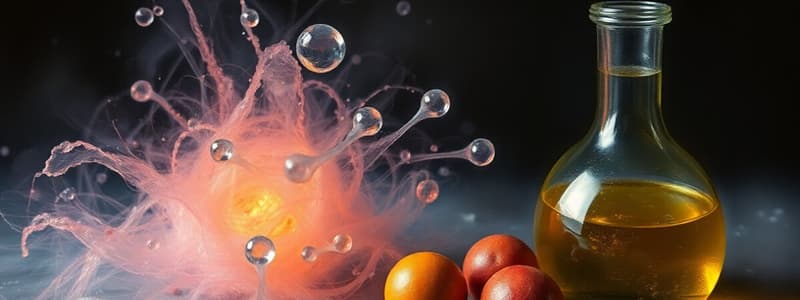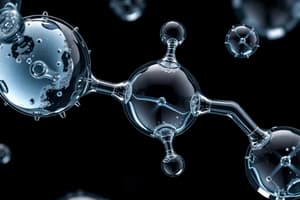Podcast
Questions and Answers
Which type of carbohydrate is composed of long chains of sugar building blocks?
Which type of carbohydrate is composed of long chains of sugar building blocks?
- Polysaccharide (correct)
- Monosaccharide
- Oligosaccharide
- Disaccharide
What is an example of a disaccharide?
What is an example of a disaccharide?
- Glycogen
- Lactose (correct)
- Cellulose
- Fructose
Which monosaccharide is commonly found in dairy products?
Which monosaccharide is commonly found in dairy products?
- Glucose
- Galactose (correct)
- Maltose
- Sucrose
Which of the following polysaccharides is primarily found in plants?
Which of the following polysaccharides is primarily found in plants?
What type of carbohydrates includes simple sugars like glucose and fructose?
What type of carbohydrates includes simple sugars like glucose and fructose?
What causes ions to separate and dissolve in water?
What causes ions to separate and dissolve in water?
Why does water have a higher boiling point compared to other liquids like oil or ethanol?
Why does water have a higher boiling point compared to other liquids like oil or ethanol?
What defines surface tension in a liquid?
What defines surface tension in a liquid?
What explains why sand heats up more than water under the same sunlight?
What explains why sand heats up more than water under the same sunlight?
What is the difference between cohesion and adhesion?
What is the difference between cohesion and adhesion?
Why is hydrogen bonding crucial for life on Earth?
Why is hydrogen bonding crucial for life on Earth?
Which property of water is primarily responsible for insects being able to walk on its surface?
Which property of water is primarily responsible for insects being able to walk on its surface?
What is specific heat capacity?
What is specific heat capacity?
What is the main consequence of high exposure to radiation?
What is the main consequence of high exposure to radiation?
Which type of bond is formed by the sharing of electrons between two non-metals?
Which type of bond is formed by the sharing of electrons between two non-metals?
What characteristic of water molecules allows them to form hydrogen bonds with each other?
What characteristic of water molecules allows them to form hydrogen bonds with each other?
Which property of water contributes to its role as a 'universal solvent'?
Which property of water contributes to its role as a 'universal solvent'?
What shape does the water molecule adopt due to its polar nature?
What shape does the water molecule adopt due to its polar nature?
Which of the following is NOT a property of water that supports life?
Which of the following is NOT a property of water that supports life?
What forms when a metal transfers its electrons to a non-metal?
What forms when a metal transfers its electrons to a non-metal?
Which of the following describes a polar covalent bond?
Which of the following describes a polar covalent bond?
What type of molecules are formed from joining smaller organic molecules together?
What type of molecules are formed from joining smaller organic molecules together?
Which of the following is NOT one of the four major categories of macromolecules?
Which of the following is NOT one of the four major categories of macromolecules?
What is the role of fatty acids in lipids?
What is the role of fatty acids in lipids?
What is the process by which polymers are formed from monomers called?
What is the process by which polymers are formed from monomers called?
Which type of macromolecule is primarily responsible for storing and communicating genetic information?
Which type of macromolecule is primarily responsible for storing and communicating genetic information?
What occurs during hydrolysis?
What occurs during hydrolysis?
Which monomer is associated with the macromolecule category of proteins?
Which monomer is associated with the macromolecule category of proteins?
What is one function of carbohydrates?
What is one function of carbohydrates?
What distinguishes a compound from an element?
What distinguishes a compound from an element?
Which statement accurately describes an atom?
Which statement accurately describes an atom?
Which statement is true regarding trace elements?
Which statement is true regarding trace elements?
What is defined as the atomic number of an element?
What is defined as the atomic number of an element?
What is a distinguishing feature of isotopes?
What is a distinguishing feature of isotopes?
Which of the following best describes radioactive isotopes?
Which of the following best describes radioactive isotopes?
Which particles make up the atomic nucleus?
Which particles make up the atomic nucleus?
What can happen if radiation from radioactive isotopes affects healthy cells?
What can happen if radiation from radioactive isotopes affects healthy cells?
Flashcards are hidden until you start studying
Study Notes
Matter and Elements
- Matter is composed of elements.
- An element is a pure substance that cannot be broken down by chemical reactions.
- A compound is formed when two or more elements combine in a fixed ratio.
- Compounds have unique properties that differ from their constituent elements.
- Trace elements, such as iron, zinc, and iodine, are essential for bodily functions.
- Each element is made up of unique atoms.
- An atom is the smallest unit of matter that still retains the properties of an element.
Subatomic Particles
- Atoms are composed of subatomic particles.
- The three main subatomic particles are neutrons, protons, and electrons.
- Neutrons have no charge, protons have a positive charge, and electrons have a negative charge.
- Neutrons and protons form the nucleus of an atom.
- Electrons orbit the nucleus in a cloud of negative charge.
- Neutrons and protons have almost identical masses, while electrons are much smaller and are often ignored when calculating atomic mass.
Atomic Number and Atomic Mass
- Elements differ in their number of subatomic particles.
- An element's atomic number is equal to the number of protons in its nucleus.
- An element's mass number is the sum of protons and neutrons in its nucleus.
- Atomic mass, the total mass of an atom, can be approximated by the mass number.
Isotopes
- All atoms of a specific element have the same number of protons but can differ in their number of neutrons.
- Isotopes are atoms of the same element that have different numbers of neutrons.
Radioactive Isotopes
- Some isotopes are stable and do not change over time, while others are unstable and radioactive.
- Radioactive isotopes decay over time, releasing energy in the form of radiation.
- Radioactive isotopes are used in medicine for diagnostics and treatment.
- Radiation can be beneficial for targeting cancer cells and stopping their spread.
- However, radiation can also damage healthy cells, potentially leading to side effects and long-term health risks.
- PET scanners utilize radioactive isotopes to monitor cancer growth and metabolism.
Chemical Bonds
- A chemical bond is a force of attraction between two atoms.
- Covalent bonds involve the sharing of electrons between two nonmetals.
- Polar covalent bonds have unequal sharing of electrons.
- Nonpolar covalent bonds have equal sharing of electrons.
- Ionic bonds form when electrons are transferred between a metal and a nonmetal.
- Hydrogen bonds are weak interactions that occur when a hydrogen atom bonded to a highly electronegative atom (like oxygen, nitrogen, or fluorine) interacts with another electronegative atom.
Properties of Water
- Water molecules are polar due to the uneven distribution of electrons in their polar covalent bonds.
- This polarity allows water molecules to form hydrogen bonds with each other, giving water unique properties essential for life.
- Water has:
- High boiling point
- High heat capacity
- Universal solvent properties
- High surface tension
- Cohesive and adhesive properties
Water as a Universal Solvent
- A solution is a homogeneous mixture of substances.
- The solvent dissolves the solute.
- Water is a versatile solvent due to its polarity.
- Water dissolves polar and charged molecules, making it a universal solvent.
- Water cannot dissolve nonpolar substances like oil.
Water’s Boiling Point
- Water has a high boiling point (100°C) compared to other liquids due to the strong hydrogen bonds between water molecules.
- Breaking these bonds requires significant energy during boiling.
Water’s Surface Tension
- Surface tension is the resistance to stretching or breaking the surface of a liquid.
- Water has high surface tension due to the cohesive forces of hydrogen bonds pulling molecules together.
Water’s Heat Capacity
- Heat capacity is the amount of heat needed to raise the temperature of a substance.
- Water has a high specific heat capacity (amount of energy required to raise the temperature of 1 gram of a substance by 1°C) due to the strong hydrogen bonds.
- This high capacity allows water to absorb significant heat without drastic temperature changes, making it important for temperature regulation in living organisms.
Water’s Cohesive and Adhesive Properties
- Cohesion is the attraction between molecules of the same substance, while adhesion is the attraction between different substances.
- Hydrogen bonds contribute to water's cohesive and adhesive properties.
- Cohesion allows water molecules to stick together, while adhesion allows water to adhere to other surfaces.
- These properties are crucial for plant life, enabling water transport through plants.
Biological Macromolecules
- Most biological molecules contain carbon, making life carbon-based.
- Organic compounds are compounds containing carbon.
- Carbon can form four covalent bonds, allowing for the formation of diverse organic molecules.
- Macromolecules are large polymers formed by joining smaller organic molecules called monomers.
- The four main categories of macromolecules are:
- Carbohydrates
- Lipids
- Proteins
- Nucleic acids
Polymer Synthesis and Breakdown
- Dehydration synthesis is the process of forming polymers from monomers by removing water.
- Hydrolysis is the reverse process of breaking down polymers into monomers by adding water.
Carbohydrates
- Carbohydrates serve as fuel and building materials.
- They include sugars and polymers of sugars.
- Monosaccharides are simple sugars, the basic building blocks of carbohydrates.
- Polysaccharides are polymers of many sugars.
Types of Carbohydrates
- Monosaccharides: Short carbohydrate chains (glucose, fructose, galactose). Found in vegetables, fruits, honey, and dairy products.
- Disaccharides: Two monosaccharides linked together (sucrose, maltose, lactose). Sucrose is found in table sugar and syrup, maltose in grains and starchy vegetables, and lactose in the milk of all mammals.
- Polysaccharides: Long chains of carbohydrates (starch, glycogen, cellulose). Starch is found in plants, glycogen is found in animals, and cellulose is found in plant cell walls.
Studying That Suits You
Use AI to generate personalized quizzes and flashcards to suit your learning preferences.




